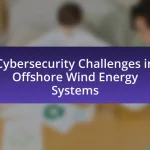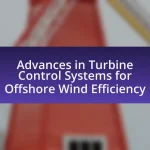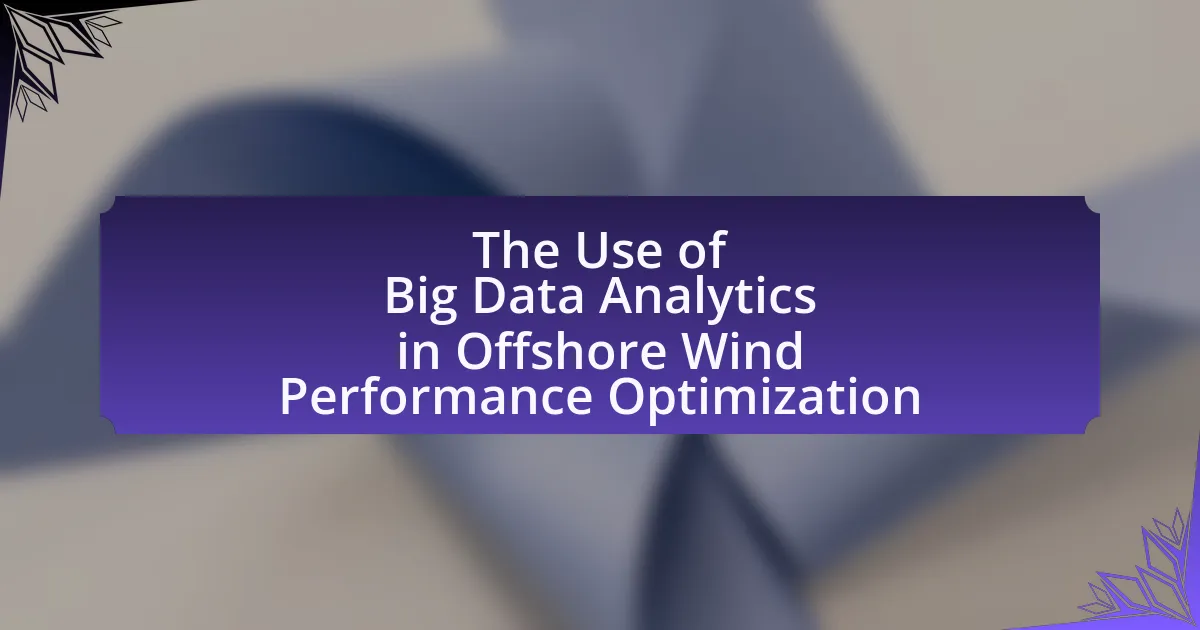The article focuses on recent advances in underwater cable technology specifically for offshore wind farms. It highlights the development of high-voltage direct current (HVDC) systems, improved cable materials, and enhanced installation techniques that collectively enhance energy transmission efficiency and reduce operational costs. Key technologies such as advanced insulation materials and fiber-reinforced composites are discussed, along with their impact on cable performance and reliability. The article also addresses challenges in cable deployment, environmental considerations, and best practices for installation and maintenance, emphasizing the importance of these innovations in supporting the scalability and efficiency of offshore wind energy projects.
What are the recent advances in underwater cable technology for offshore wind farms?
Recent advances in underwater cable technology for offshore wind farms include the development of high-voltage direct current (HVDC) systems, improved cable materials, and enhanced installation techniques. HVDC systems allow for more efficient long-distance electricity transmission, reducing energy losses compared to traditional alternating current (AC) systems. Innovations in cable materials, such as the use of advanced polymers and improved insulation, enhance durability and resistance to environmental factors, thereby increasing the lifespan of the cables. Additionally, advancements in installation techniques, including the use of remotely operated vehicles (ROVs) and automated cable laying systems, have improved the precision and efficiency of cable deployment, minimizing installation time and costs. These technological improvements are crucial for the scalability and reliability of offshore wind energy projects.
How have these advances improved the efficiency of offshore wind farms?
Advances in underwater cable technology have significantly improved the efficiency of offshore wind farms by enhancing energy transmission and reducing losses. The development of high-voltage direct current (HVDC) systems allows for the transmission of electricity over long distances with minimal energy loss, which is crucial for offshore installations that are often located far from shore. Additionally, advancements in cable materials and insulation have increased durability and reduced maintenance needs, leading to more reliable operations. For instance, the use of advanced polymer materials has improved resistance to environmental factors, thereby extending the lifespan of the cables. These technological improvements collectively contribute to higher energy output and operational efficiency in offshore wind farms.
What specific technologies have been developed to enhance cable performance?
Specific technologies developed to enhance cable performance include advanced insulation materials, such as cross-linked polyethylene (XLPE), which improve thermal and electrical properties. Additionally, the use of fiber-reinforced polymer (FRP) composites in cable construction increases strength and reduces weight, facilitating easier installation and maintenance. Furthermore, innovations in cable design, such as the incorporation of dynamic cable systems that can adapt to environmental conditions, enhance durability and reliability. These advancements are supported by industry studies indicating that XLPE cables can operate at higher temperatures and have a longer lifespan compared to traditional materials, while FRP composites have shown significant reductions in corrosion and fatigue under harsh marine conditions.
How do these technologies impact energy transmission rates?
Advances in underwater cable technology significantly enhance energy transmission rates by reducing losses and increasing capacity. For instance, high-voltage direct current (HVDC) systems, which are often employed in modern underwater cables, can transmit electricity over long distances with minimal energy loss compared to traditional alternating current (AC) systems. Research indicates that HVDC can achieve transmission efficiencies exceeding 95%, while AC systems typically experience losses of around 10% over similar distances. Additionally, innovations such as improved insulation materials and advanced cable designs allow for higher current-carrying capacities, further optimizing energy flow from offshore wind farms to onshore grids.
What challenges do these advances address in underwater cable deployment?
Advances in underwater cable technology address several challenges in underwater cable deployment, including installation efficiency, environmental impact, and durability. These technologies enhance the speed and accuracy of cable laying operations, reducing the time and costs associated with deployment. For instance, innovations such as advanced cable-laying vessels and automated systems minimize the risk of damage during installation, which is critical given that underwater cables are often exposed to harsh marine conditions. Additionally, improved materials and designs increase the lifespan of cables, ensuring they can withstand underwater pressures and corrosive environments, thereby reducing maintenance needs and enhancing reliability.
What environmental factors are considered in the design of underwater cables?
The environmental factors considered in the design of underwater cables include seabed conditions, marine life impact, water depth, and potential for natural hazards. Seabed conditions, such as sediment type and stability, influence cable burial methods and protection measures. The impact on marine life is assessed to minimize disruption to ecosystems, particularly during installation. Water depth affects cable design specifications, including insulation and buoyancy requirements. Additionally, potential natural hazards like underwater landslides, fishing activities, and anchoring risks are evaluated to ensure cable integrity and longevity. These considerations are critical for the successful deployment and operation of underwater cables in offshore wind farms.
How do advances mitigate risks associated with underwater cable failures?
Advances in underwater cable technology mitigate risks associated with cable failures through enhanced materials, improved installation techniques, and advanced monitoring systems. The use of high-strength, corrosion-resistant materials increases the durability of cables, reducing the likelihood of damage from environmental factors. Improved installation techniques, such as precision laying and burial methods, minimize the risk of external impacts that could lead to failures. Additionally, advanced monitoring systems, including real-time data analytics and remote sensing technologies, allow for early detection of potential issues, enabling proactive maintenance and reducing downtime. These advancements collectively contribute to a more reliable and resilient underwater cable infrastructure for offshore wind farms.
How do underwater cables function in offshore wind farms?
Underwater cables function in offshore wind farms by transmitting the generated electricity from wind turbines to the onshore grid. These cables are designed to withstand harsh marine environments and are typically insulated to prevent electrical leakage and damage from seawater. The cables connect individual turbines to a central offshore substation, where the electricity is collected and converted to a suitable voltage for transmission to land. This process is essential for integrating renewable energy into the electrical grid, as offshore wind farms can produce significant amounts of energy, with some projects generating over 1,000 megawatts.
What are the key components of underwater cable systems?
The key components of underwater cable systems include the cable itself, cable protection systems, repeaters, and landing stations. The cable is typically composed of multiple layers, including conductors for electricity transmission, insulation, and protective sheathing to withstand underwater conditions. Cable protection systems, such as armoring and burial techniques, safeguard the cable from environmental hazards and fishing activities. Repeaters are used to amplify signals over long distances, ensuring effective communication and power transmission. Finally, landing stations serve as the interface between the underwater cable and terrestrial networks, facilitating the connection to power grids or data networks. These components work together to ensure the reliability and efficiency of underwater cable systems, which are essential for offshore wind farms and other marine applications.
How do these components interact to ensure reliable energy transmission?
The components of underwater cable technology, including conductors, insulation, and protective layers, interact to ensure reliable energy transmission by minimizing energy loss and protecting against environmental factors. Conductors transmit electrical energy efficiently, while high-quality insulation prevents leakage and maintains signal integrity. Protective layers shield the cables from physical damage and corrosion, which are critical in harsh underwater environments. For instance, advancements in materials such as cross-linked polyethylene (XLPE) enhance insulation performance, allowing for higher voltage transmission and reducing thermal losses. These interactions collectively contribute to the overall reliability and efficiency of energy transmission in offshore wind farms.
What materials are commonly used in the construction of underwater cables?
Underwater cables are commonly constructed using materials such as copper or aluminum for the conductors, polyethylene or polyvinyl chloride (PVC) for insulation, and steel or other alloys for armoring. Copper and aluminum are chosen for their excellent electrical conductivity, while polyethylene and PVC provide effective insulation against water and environmental factors. Steel armoring is utilized to protect the cables from physical damage and external pressures encountered in underwater environments. These materials are critical for ensuring the durability and functionality of underwater cables, particularly in applications related to offshore wind farms.
What role do underwater cables play in the overall infrastructure of offshore wind farms?
Underwater cables are essential for the infrastructure of offshore wind farms as they facilitate the transmission of electricity generated by wind turbines to the onshore grid. These cables connect the turbines to substations, ensuring efficient energy transfer over long distances. The reliability and capacity of underwater cables are critical, as they must withstand harsh marine conditions while minimizing energy loss. For instance, advancements in cable technology, such as improved insulation and materials, enhance durability and performance, supporting the growing demand for renewable energy.
How do they connect wind turbines to the grid?
Wind turbines connect to the grid through underwater cables that transmit generated electricity to onshore substations. These cables are designed to handle high voltage and minimize energy loss during transmission. The process typically involves the installation of subsea cables that link multiple turbines to a central point, where the electricity is converted to a suitable voltage for integration into the national grid. This method is essential for offshore wind farms, as it allows for efficient energy transfer over long distances, ensuring that the renewable energy produced is effectively utilized.
What are the implications of cable layout and design on energy distribution?
Cable layout and design significantly impact energy distribution by influencing efficiency, reliability, and operational costs. A well-planned cable layout minimizes energy losses through optimized routing and reduces the risk of damage from environmental factors, which is crucial for offshore wind farms. For instance, the National Renewable Energy Laboratory reports that proper cable design can decrease resistive losses by up to 10%, enhancing overall energy transmission efficiency. Additionally, strategic cable placement can facilitate easier maintenance and reduce downtime, further improving energy distribution reliability.
What future trends are expected in underwater cable technology for offshore wind farms?
Future trends in underwater cable technology for offshore wind farms include the development of higher-capacity cables, improved materials for enhanced durability, and advancements in installation techniques. Higher-capacity cables, such as those utilizing superconducting materials, are expected to increase energy transmission efficiency and reduce losses. Improved materials, like advanced polymers and composite materials, will enhance resistance to environmental factors, thereby extending the lifespan of cables. Additionally, innovations in installation techniques, including autonomous underwater vehicles and advanced cable-laying methods, will streamline deployment and reduce costs. These trends are driven by the growing demand for renewable energy and the need for more efficient offshore wind energy systems.
How is innovation shaping the future of underwater cable systems?
Innovation is significantly shaping the future of underwater cable systems by enhancing their efficiency, durability, and capacity to support renewable energy sources like offshore wind farms. Advanced materials, such as high-performance polymers and composite materials, are being developed to improve the resilience of cables against harsh underwater conditions, thereby extending their lifespan. Additionally, innovations in cable design, including the integration of smart technology for real-time monitoring and maintenance, are increasing operational efficiency. For instance, the use of fiber-optic sensors within cables allows for continuous assessment of cable integrity and performance, which is crucial for minimizing downtime and optimizing energy transmission. These advancements are essential as the global demand for renewable energy continues to rise, necessitating more robust and efficient underwater cable systems to connect offshore wind farms to the grid.
What emerging technologies are being researched for underwater cables?
Emerging technologies being researched for underwater cables include advanced materials, such as high-temperature superconductors, and innovative cable designs that enhance efficiency and durability. Research indicates that high-temperature superconductors can significantly reduce energy loss during transmission, making them a promising option for future underwater cable systems. Additionally, the development of hybrid cables that integrate power and data transmission capabilities is gaining attention, as they can support the increasing demand for both electricity and communication in offshore wind farms. Studies, such as those conducted by the European Marine Energy Centre, highlight the potential of these technologies to improve the performance and reliability of underwater cable systems in renewable energy applications.
How might these innovations affect the scalability of offshore wind farms?
Innovations in underwater cable technology significantly enhance the scalability of offshore wind farms by enabling more efficient energy transmission and reducing installation costs. Advanced materials and designs allow for longer cable lengths and improved performance under harsh marine conditions, which facilitates the connection of larger wind farms to the grid. For instance, the development of high-voltage direct current (HVDC) systems can transmit electricity over greater distances with lower losses compared to traditional alternating current systems. This capability supports the deployment of wind farms further offshore, where wind resources are often stronger and more consistent, thus increasing overall energy production potential.
What best practices should be followed for the installation and maintenance of underwater cables?
Best practices for the installation and maintenance of underwater cables include thorough site surveys, proper cable laying techniques, and regular inspections. Conducting detailed site surveys ensures that the cable route is free from obstacles and hazards, which minimizes the risk of damage during installation. Employing appropriate cable laying techniques, such as using specialized vessels and equipment, helps to prevent cable entanglement and ensures proper burial depth, which is crucial for protecting the cables from environmental factors. Regular inspections, including visual assessments and remote monitoring, are essential for identifying potential issues early, thereby prolonging the lifespan of the cables and ensuring reliable operation. These practices are supported by industry standards and guidelines, such as those from the International Electrotechnical Commission, which emphasize the importance of safety and reliability in underwater cable systems.
What are the common pitfalls to avoid during installation?
Common pitfalls to avoid during installation of underwater cables for offshore wind farms include inadequate site surveys, improper cable handling, and failure to account for environmental conditions. Inadequate site surveys can lead to unforeseen obstacles, such as rocky seabeds or existing infrastructure, which can complicate installation and increase costs. Improper cable handling, including excessive bending or tension, can damage the cable and reduce its lifespan. Additionally, failing to account for environmental conditions, such as currents and weather patterns, can result in delays and safety hazards during installation. These factors are critical to ensure a successful and efficient installation process.
How can regular maintenance improve the lifespan of underwater cables?
Regular maintenance significantly improves the lifespan of underwater cables by identifying and addressing potential issues before they escalate into major failures. Routine inspections can detect wear, corrosion, and damage caused by environmental factors, allowing for timely repairs that prevent costly outages. For instance, studies have shown that proactive maintenance can extend the operational life of underwater cables by up to 30%, as it minimizes the risk of unexpected failures and the need for extensive repairs or replacements. This approach not only enhances reliability but also optimizes the overall performance of offshore wind farms, ensuring that energy transmission remains efficient and uninterrupted.




